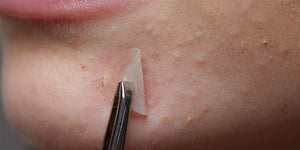But what makes pimple patches work? Are they really as effective as all the other online articles and commercials make us believe? What type of acne and zits can be fixed with a simple pimple patch? Can pimple patches be bad for you? Let’s answer all these questions and more in order to elucidate the mystery around pimple patches, while also finding out the science behind them. Because yes, there is science involved!
Do pimple patches work?
In order to answer this question, we must understand a couple of things: what types of acne can be "treated" with pimple patches, as well as the active ingredients that are found inside them. Let’s start with the beginning.
First of all, you must know that pimple patches are not effective on all types of acne. Acne types can differ from the common whiteheads, blackheads and papules (red inflamed bumps) to more complex cases such as cystic acne or nodules, both of which can be large, painful, deeply rooted and can leave scars.
Pimple patches are, indeed, effective, just not on all types of acne. Acne patches work on whiteheads and pustules, for example; in short, blemishes that have a head and pus inside which can be dried or absorbed by the active acne-fighting ingredients.
On the other hand, hydrocolloyd acne patches are not effective on blackheads, but there are some types of micro-needle pimple patches that work on cystic acne because they penetrate deeper into the skin. We’ll talk about each of these patches and the differences between them below.
Your go-to solution kit for clearing late-stage whiteheads overnight, 72pcs
Your zit-free emergency kit for reducing early-stage painful & deep pimples, 18pcs

The science behind acne patches
Now we got to the interesting part. In order to understand whether pimple patches are effective or not, we must understand the simple science behind them. And it really is simple!
A pimple patch looks exactly like a sticker and it is made of two main components. First, there’s the thin, waterproof adhesive layer that works as a protective barrier for your pimple and that helps create a moist, sealed medium around your zit. Second, there’s the gel-like substance that contains all the active ingredients with acne-fighting properties. This layer comes in direct contact with the skin. The ingredients can vary from the super popular hydrocolloid to more classic substances such as salicylic acid, tea tree oil or benzoyl peroxide. All these are effective in drying the fluids from acne spots such as oils and pus and in reducing inflammation.
By applying a pimple patch and leaving it on for a few hours (or preferably overnight), you can help speed up the healing process without affecting the surrounding skin.
The different types of pimple patches
As we mentioned before, there are different types of pimple patches out there destined for different types of acne.
There are the classics: pimple patches with salicylic acid and pimple patches with tea tree oil or even benzoyl peroxide, also known as medicated acne patches. This type of patches can be left on the skin for a few hours and their role is to dry the pimples.
Then, there are the super popular hydrocolloid patches, which are the latest obsession in the skincare industry at the moment; these are non-medicated pimple patches.
Hydrocolloid is a gel-like substance that is dry at first. After we stick the sticker to the pimple, the gel starts absorbing all the liquids from the inside of the zit and it hydrates itself, transforming into a matte white layer.
Traditionally, hydrocolloid has been used by doctors to treat open wounds for centuries now, so its benefits have been tested and confirmed over time.
Only recently people have figured out that the same science can be applied for pimples as well – and it has been proven useful ever since.
Your go-to solution kit for clearing late-stage whiteheads overnight, 72pcs
Then, there are pimple patches for cystic acne. Which brings us to a very common question: Do pimple patches work on cysts? Although most dermatologists are saying that classic acne patches are not effective on this type of complex acne that provokes cysts and nodules, there might be a solution. We’re talking about pimple patches with needles, which aren’t nearly as scary as the name sounds. This type of patches is made of microscopically-sized needles that will gently penetrate the deeper layers of the skin; then the needles will dissolve, releasing the active ingredients in the skin. Although this type of pimple patches is said to not be 100% efficient in all cases, it definitely doesn’t hurt trying.
Your zit-free emergency kit for reducing early-stage painful & deep pimples, 18pcs
Last but not least, there’s another frequently asked question: Do pimple patches work on blackheads? And the short answer is ‘no’ because the ingredients inside can’t do anything for closed pores, closed lesions or comedones. The acne-fighting ingredients only work on open wounds and pus-filled pustules.

How to use pimple patches
One of the best things about pimple patches is how easy they are to use. There a few super simple steps that you need to follow:
- Gently clean your skin and pat it dry. Make sure your skin is completely dry before sticking the patch, otherwise it won’t adhere as well;
- Unwrap the pimple patch from its protective foil and apply it on your pimple; make sure you’re using an acne patch that’s slightly larger than your zit, so you can ensure complete covering, especially at the margins;
- Leave your sticker on for as long as the package mentions – this usually means for a few hours, overnight or even for an entire day for hydrocolloid patches;
- When the time expires, gently remove the patch by raising its surrounding edges and then the center. Afterwards, gently clean your skin with a cleanser.
- Apply a new patch if needed, repeating the entire procedure described above.
A big advantage of pimple patches is the fact that they’re so thin and subtle, you can even apply make-up such as foundation on top of them. This will improve the aspect of your blemish, while also keeping your pores safe and unclogged.

Why do pimple patches turn white?
This is a very popular curiosity around pimple patches. After a couple of hours, hydrocolloid pimple patches will turn from transparent to an opaque white color. Although some people might get scared or intimidated by this, thinking that maybe the white part is a layer of their skin that has been damaged and now is stuck to the sticky part of the patch, this is not true. The white substance is, in fact, hydrated hydrocolloid. Hydrocolloid starts out like a dry, transparent gel that comes in direct contact with your pus-filled or oozing pimple. Then, the hydrocolloid starts “sucking” all the fluids in and around your pimple, such as oils or pus. This process causes the hydrocolloid to hydrate itself and change from transparent to white.
Hence, when you remove a pimple patch and see that it is now white, this only means that the science behind it worked and it has done its job! After 8 to 24 hours (depending on the patch), you can take off your sticker and apply a new one if needed. No worries, as the new one will turn white as well and there’s nothing wrong with that!

Conclusion: pimple patches do work!
So, are pimple patches good? After explaining the entire science behind acne patches and the ingredients they contain (hydrocolloid, salicylic acid, tea tree oil and benzoyl peroxide) as well as how to use them, which types of acne can they be used on and more, we’re pretty sure there’s no mystery left around this spot treatment!
Pimple patches are a type of spot treatment, so they cannot cure your acne from the inside, they cannot make it disappear overnight and they also cannot prevent acne in general. Pimple patches only work on already-existing pimples and they’re a quick and efficient way of getting rid of stubborn zits faster.
In short, pimple patches definitely work thanks to the simple science behind them: they’re waterproof stickers that create an air-tight, waterproof protective barrier where acne-fighting ingredients can do their job: dry your zits and absorb all the nasty fluids from the inside.
There are some cases in which it is advised not to use pimple patch – for example if you have dry or sensitive skin. In case you’re unsure whether that’s your case or not, we recommend to check with your dermatologist before using acne patches.
Where to buy pimple patches from?
Check out our collection of pimple patches, for both deep zits and whiteheads.
Hugs!
Adrienne | Co-founder of OMMA Cosmetics
Photo sources: OMMA








